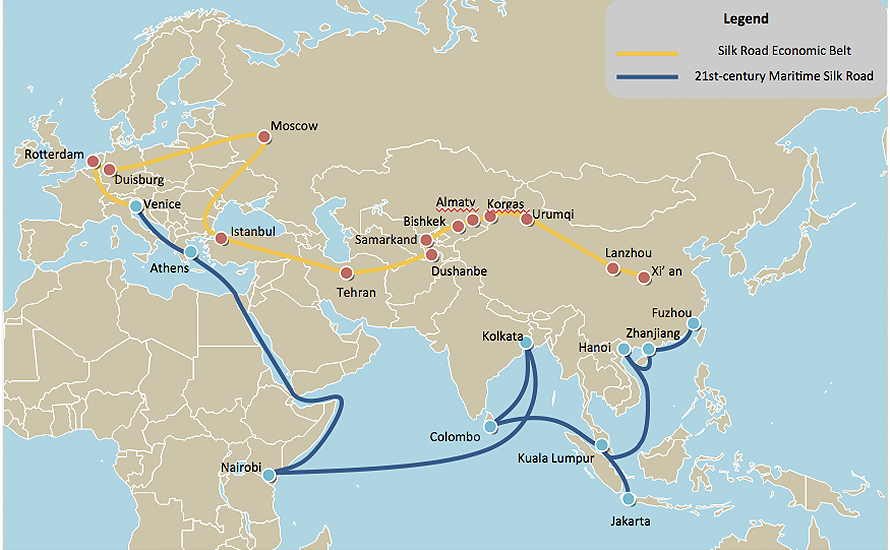The 'One Belt-One Route' project aims to consolidate China's rise as a superpower
The ambitious initiative launched by Xi Jinping to connect China with the rest of the Eurasian continent can be costly and difficult. But unlike the land route through the republics of Central Asia, the seaway can soon be a reality in certain sections, as China has already built some ports in part of the route.

▲The two ways for the 'One Bell-One Route' project [yourfreetemplates]
ARTICLE / Jimena Puga Gómez [Spanish version]
After the speech of the Chinese president Xi Jinping in 2013 about revitalizing the ancient Silk Road, the project that started as a simple idea has become the biggest challenge for the world economy, a total revolution in the infrastructures of people’s transports, goods, hydrocarbons and high technology. Known as One Belt-One Road (OBOR), this plan is expected to be key for the Chinese supremacy as a superpower over the rest of the countries.
OBOR is now a great plan for redesigning the strategic environment of China, projecting the Chinese economic power, guaranteeing China the access to energy and minerals and stimulating the economic growth in western China. OBOR tries to reach these objectives by promoting a better connectivity between China and Europe through the development of intermediate points in the center, west and south of Asia.
The maritime route, one of the OBOR's key pieces (also known as the Maritime Silk Road of 21st century), will take advantage of the fact that seven of the world's ten biggest harbors are in China, something that helped China to become an important exporter of services of port management.
The maritime Silk Road headed to the East will start in the province of Fujian and will cross Guangdong, Guangxi and Hainan before directing towards the South until the Strait of Malacca. From Kuala Lumpur, the Route will go through Kolkata and Colombo, then it will cross the rest of the Indic Ocean to Nairobi. From Nairobi, it will go to the North around the African Horn and it will move over the Red Sea towards the Mediterranean, with a stop in Athens before coming across with the terrestrial part of the Belt in Venice. In accordance with the maritime tract towards Europe, China’s investment has focused on the Piraeus Port (Greece), and on the development of a network of logistic infrastructures over the Balkans and Hungary. In this strategic map of routes the South Pacific is also included.
To sum up, the Maritime Silk Road is composed by two routes: one from China over the South Sea of China until the harbors of the Indic Ocean, expanding towards Europe; and the other one over the South Sea of China which extends from the East to the South Pacific.
In spite of being a long-term economic project, the Chinese Government has already started the construction of some infrastructures and a series of negotiations with different countries. A clear example is Germany. The EU is the biggest commercial partner of China, while China is the second for the EU. In addition to its great reputation as a reliable partner, Germany is considered as the “door to Europe”. In Duisburg, the biggest indoor harbor of the world, Xi Jinping proposed to Germany working together in order to make possible the new Silk Road. Nowadays, Germany and China are connected by the railway international line Chongqing-Xinjiang- Duisburg. China, in this negotiation period, has shown its capacity to take advantage of its new skill of modernizing and administrating harbors to enforce its strategy.
The initiative of the new Silk Road focuses on the collective construction of fluent, secure and efficient routes of transport which will connect the main harbors along the route. The effects of this economic net ensure benefits not only for China as the leader of the OBOR, but also for all the countries affected by it. However, the financing of the project is still an unknown that should be clarified.